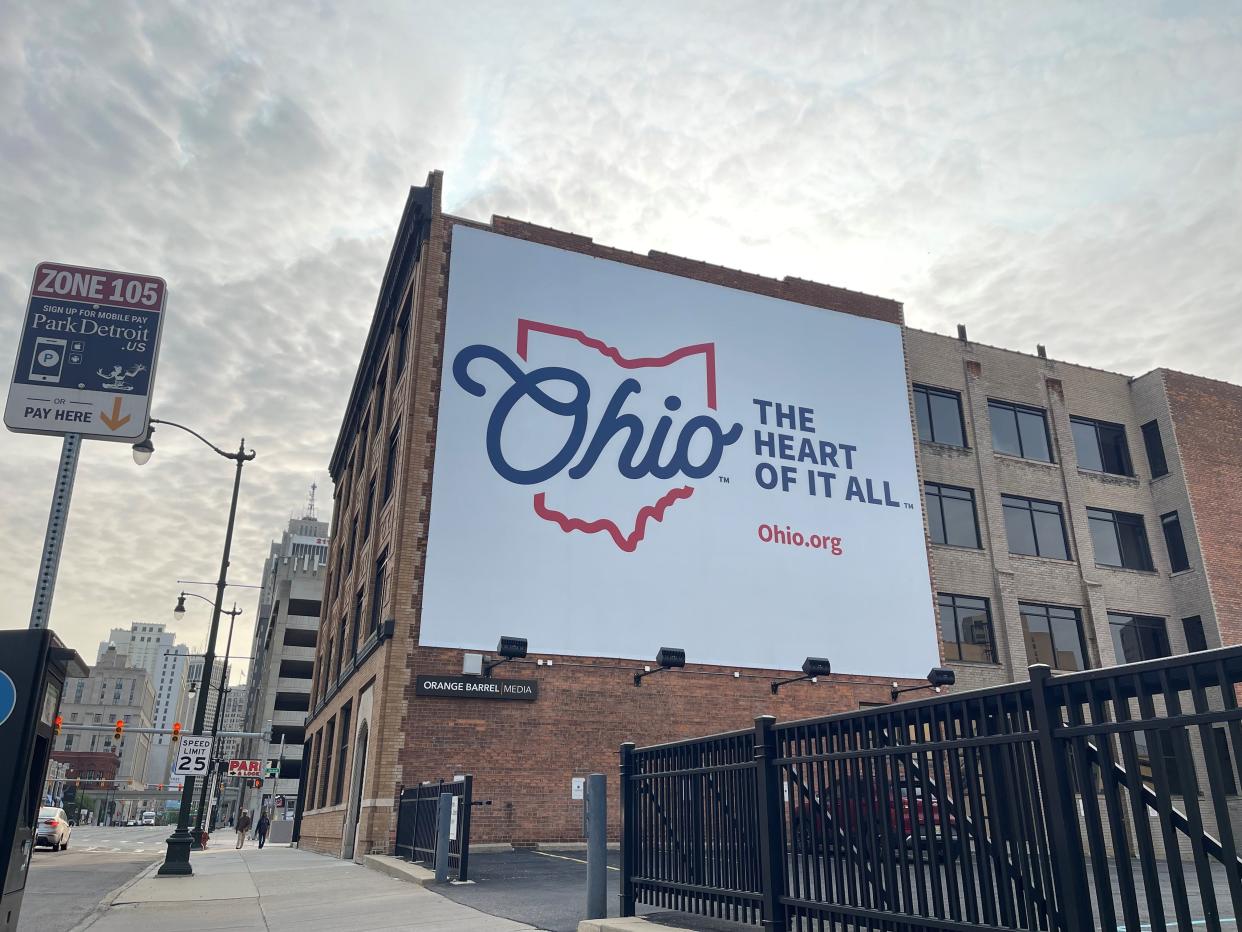Ohio spending millions on new effort to get people to visit and then move here

Ohio wants you to come to visit, but it would rather you stay awhile.
The state's tourism arm is using a portion of its $10 million-a-year budget to attract Midwesterners to spend more time in the Buckeye State than a weekend trip to Hocking Hills or Cedar Point.
That's because Ohio needs more workers to attract businesses like Intel and Honda to manufacture microchips and electric vehicle batteries here. The state's population grew by a mere 2.3% between 2010 and 2020, outpaced by a 7.4% increase nationwide and a 3.1% increase in the Midwest over that decade, according to U.S. Census Bureau data.
But some in Ohio's tourism industry worry that the state is spreading itself too thin, spending money to market the state that was intended for attracting visitors. And Ohio Senate changes would cut that budget to $7.5 million a year.
"There are all kinds of reasons why we want to attract people to live in Ohio. We support that," said Andy Herf, executive director Ohio Association of Convention and Visitor Bureaus. "But in making that decision, a lot of people are going to become familiar with Ohio by traveling here first. We don’t want to lose focus on that tourism messaging."
John Barker, president & CEO of the Ohio Restaurant Association, questions whether $10 million, or less, a year can cover attracting both visitors and future residents. "I’m not sure that’s going to be enough," he said.
Ohio is spending $3.6 million on marketing for its new tourism slogan, "Ohio, the Heart of it All," alone in May and June. The campaign included television ads, billboards and wallscapes in both Ohio (a $2.1 million spend) and surrounding states ($1.5 million), according to the Ohio Department of Development.
But Ohio Department of Development Director Lydia Mihalik says the same message that will bring someone to Ohio for a long weekend will also entice them to stay much longer.
"Whether you're getting people to consider a visit or whether we're getting them to consider a move, we're all still talking about the same places," Mihalik said. "We've got a great story in Ohio to tell and we feel very strongly if we continue to be bold about our advocacy for Ohio, we're going to be very successful."

Why Ohio needs more people
Ohio, like many Midwestern states, hasn't kept up with population growth in other parts of the country.
Between 2020 and 2022, 68 of Ohio's 88 counties lost population, according to Census estimates. Most of the state's growth has been focused in central Ohio and the counties surrounding Cincinnati.
Ohio is also among the states with the oldest population with 17.8% of its residents over 65 years old compared to 16.8% nationally. Maine and Florida both topped 21%, according to 2021 Census data.
As Intel breaks ground on its $20 billion computer chip plants in New Albany outside Columbus, the company needs workers.
"We're creating jobs faster than we can find people to fill them," Mihalik said. "Because of our demographic trends, we know that the fastest way that we can get people to the state of Ohio to fill those jobs is through migration."
Who is Ohio trying to attract?
In pursuit of new residents, Ohio is picking a bit of a fight with its neighbor to the north. Ohio is paying for billboards in Detroit touting the state's charm as "The Heart of it All" − Ohio's new tourism slogan resurrected from the 1980s.
"We've garnered a ton of earned media just by putting a couple of wallscapes in downtown Detroit," Mihalik said. "It's playful. It was intentional. We wanted to get people up there talking."
Media in Detroit and Columbus reported on the billboards. Michigan Gov. Gretchen Whitmer hit back on Twitter: "Michigan: Always living in Ohio’s head rent-free."
Whitmer, a Democrat, has promoted Michigan as a more welcoming alternative to Ohio, particularly for LGBTQ residents and those seeking abortions. In her State of the State address, Whitmer said: "I’ll go to any state that restricts people’s freedoms and win business and hardworking people from them. I’m looking at you, Ohio and Indiana."
Detroit isn't Ohio tourism's only target. Ohio is promoting its message in 28 markets with ads in Indiana, Kentucky, Michigan, Pennsylvania and West Virginia. Eight of those markets are within Ohio, convincing residents to take a trip to a park or attraction on the other side of the state.
A proposed change in the state budget would rename TourismOhio as the State Marketing Office, charging it to promote not just tourism but also "living, learning, and working" in Ohio.
But Herf points out that Ohio's budget for attracting both residents and visitors is smaller than some of those states' allocations for tourism alone. Michigan spends $40 million on its "Pure Michigan" campaign, according to MLive.com. West Virginia recently allocated $67 million for tourism over two years and Kentucky announced it would spend $75 million in federal recovery dollars to attract visitors after the COVID-19 pandemic.
In 2021, Ohio Gov. Mike DeWine wanted to spend $50 million on a marketing campaign to convince East Coast and West Coast residents to live and work in the Buckeye State. During his pitch, he called Ohio "a progressive state," which drew immediate backlash from those who said the GOP-controlled Legislature's pro-gun, anti-abortion and anti-LGBTQ policies were anything but progressive.
Lawmakers later canned DeWine's proposed spending. JobsOhio did create billboards touting Ohio's low cost of living compared to New York City's and other large metropolises.
Barker with the Ohio Restaurant Association said Ohio needs to stay competitive with its neighbors. The state's culinary scene can help do the rest. Ohio had four James Beard award nominees in 2023 and well-known restaurants from chef Michael Symon's establishments in Cleveland and Cincinnati restaurateur Jeff Ruby's steakhouses.
"We fight above our weight," Barker said. Ohio tourism had a record year in 2022, attracting 233 million visitors to spend $53 billion in the state.
Do ads bring people to Ohio?
At the end of the day, will an ad convince someone to move to Ohio?
People move to Ohio for a variety of reasons, including family (43.6%), jobs (39.2%) and retirement (10%), according to a 2021 United Van Lines' survey. The survey did not review the impact of states' marketing or incentives, a spokesperson said.
Lifestyle, at 9%, was lower on the list. Democrats say Republican politicians who control state government aren't rolling out the welcome mat with policies that alienate LGBTQ Ohioans and women seeking abortions or other reproductive options.
And Ohioans had a more favorable view of the state than those considering a move, according to research provided by TourismOhio, the state's tourism arm.
Likely movers were less likely to think of Ohio as a state with options for outdoor activities (38% versus 68% of Ohioans surveyed), affordable cost of living (34% versus 66% of Ohioans) and wide availability of housing (35% versus 61%).
Visitors did have a better impression of Ohio after seeing an ad and taking a trip to the state, according to the research. Those who did both were twice as likely to think of the state as a good place to live and start a career.
"That is why we have really doubled down on not only promoting the state as a great place to visit, but also a great place to live," Mihalik said.
Jessie Balmert is a reporter for the USA TODAY Network Ohio Bureau, which serves the Columbus Dispatch, Cincinnati Enquirer, Akron Beacon Journal and 18 other affiliated news organizations across Ohio.
Get more political analysis by listening to the Ohio Politics Explained podcast
This article originally appeared on Cincinnati Enquirer: Ohio spends tourism money to attract new residents

